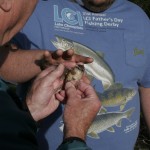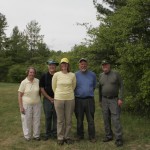Determined hummer hangs at feeder despite chilly temperatures We have had a few frosty mornings here at Crown Point with ice on the net bags three different mornings.
The warmer water of the lake didn’t even protect us from the cold temperatures.
The birds that were out those mornings were sitting in the sun to get warm even before they ate a few green worms.
The worms that live in the leaves of the hawthorns are one of the reasons so many birds stop at Crown Point to refuel before going further north.
One frosty morning several of the little green worms left their curled up leaves and spun a single strain web to the ground. They will live in the soil for a little while before hatching into moths.
All those frosty single webs in the morning sunrise made for a neat picture.
I don’t have the final total of birds banded during the two weeks at Crown Point but we did pass 300 over the weekend with 53 different species.
The best bird we banded—a Carolina wren—had never been recorded there before.
It is one of those birds that has been moving north with the climate change and has been seen nesting and at feeders in the Champlain Valley for a few years.
Now one is wearing a band.
The seven-year and eleven-months-old black capped chickadee that I wrote about last week was also special to the site.
We banded 15 different species of warblers and saw a couple others in the trees that we didn’t catch.
Yesterday we saw a Canada Warbler which hung around and sang nearby most of the day, but it never got caught.
A good number of cormorants returned this week and we counted nearly 100 on Wednesday night.
They weren’t on the site where they tried to nest last year but they were hanging out with over 150 gulls on a rock spit.
We watched as an osprey dove on the flock like an eagle and put them all in the air.
We kept a list of all the birds we saw and heard for the two weeks we were there and ended up with a total of 105.
The last bird to make the list was an American bittern that we heard calling this morning (5/10) at dawn.
We had a pair of resident great horned owls that came up from the lake each night calling and hunting for food for their young.
Late yesterday the crows found one of these owls about four in the afternoon and the chase was on.
The crows harassed this owl until dark and for the first evening since we were there the owl didn’t come around last night.
Each evening a woodcock did his aerial flights and ground calling while trying to attract a mate.
The third night there we set up a net in his calling spot and he took his first flight just before dark.
He came right down on target and we caught him and put a band on him.
We took down the net right away and it wasn’t an hour later that the bird was right back calling in the same spot.
Last night I showed some people the bird as he came down to parade on the ground in the same place where we caught him.
Banding him didn’t seem to change his routine.
Well, snow in May has happened again and Karen said the hummer didn’t like it very much. He just sat by the feeder shaking and taking a drink now and then.
Being such little birds you would think they would freeze to death. They slow down their heart rate and use less energy to make it through times like these.
Some of the insect-eating birds don’t do this and they have to find food or perish.
Back in the 80’s we had a foot of snow on Mother’s Day which lasted three days.
Many little birds went to the sand beaches looking for food as that was where the only bare spots on the landscape could be found.
They died in big numbers. Warblers, tanagers, sparrows, buntings and vireos were all dead along area beaches.
Many locals called and asked what they could do for those birds.
The Ravens had a feast for several days and had plenty of food in the nest for their young.
The beauty of spring green, but that’s another story. See ya.


